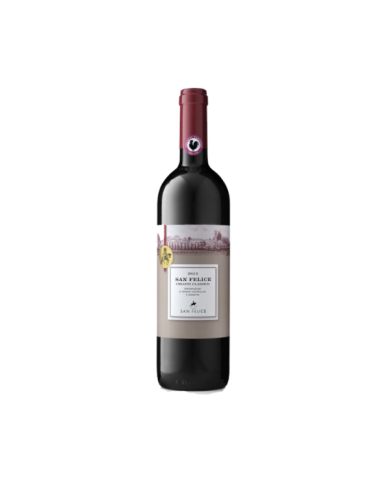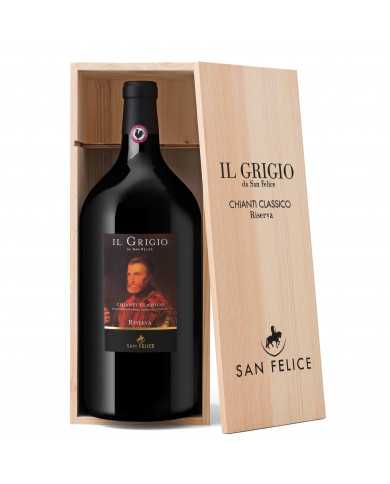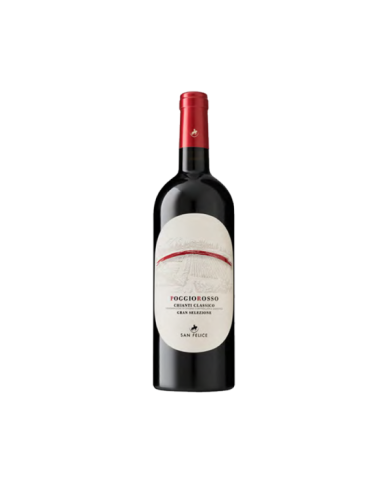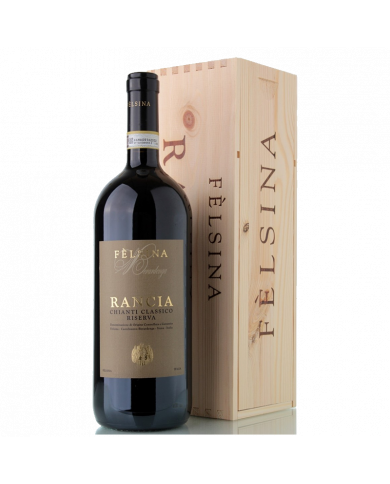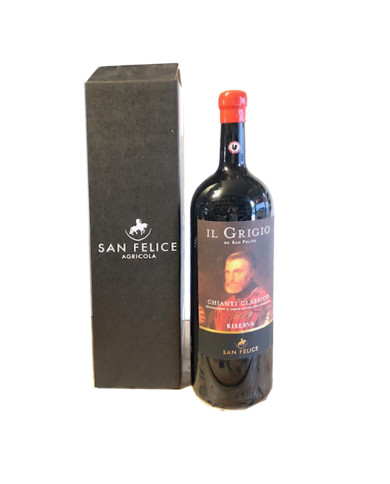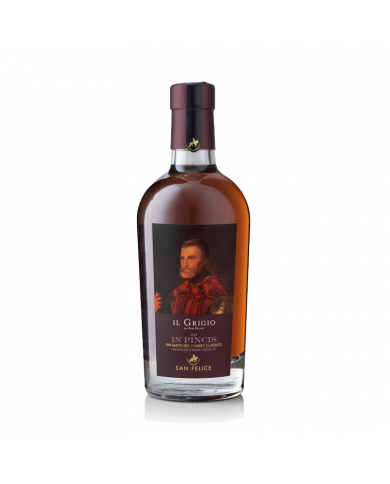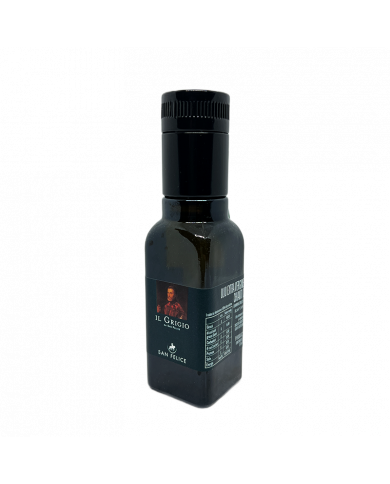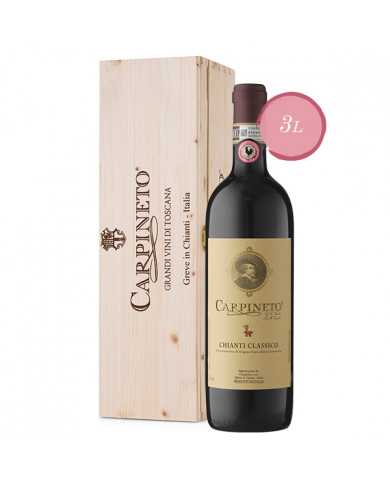Produced entirely with native grapes, Sangiovese mainly with additions of Colorino and Pugnitello, it is a typical Chianti Classico, of medium structure, with a strong personality that stands out in particular for its elegance. The vinification takes place in the traditional way, with medium length maceration, followed by a maturation of the wine for 12 months in Slavonian oak barrels.
Produced entirely with native grapes, Sangiovese mainly with additions of Colorino and Pugnitello, it is a typical Chianti Classico, of medium structure, with a strong personality that stands out in particular for its elegance. The vinification takes place in the traditional way, with medium length maceration, followed by a maturation of the wine for 12 months in Slavonian oak barrels.
Only the best Sangiovese grapes selected in the company's Chianti Classico vineyards make up this Reserve, a valid combination of tradition and modernity. It ages for about 24 months in wood, of which a part (about 20%) in barriques, and one year in bottle. The label depicts a famous painting by Titian 'Man with armor'.
Only the best Sangiovese grapes selected in the company's Chianti Classico vineyards make up this Reserve, a valid combination of tradition and modernity. It ages for about 24 months in wood, of which a part (about 20%) in barriques, and one year in bottle. The label depicts a famous painting by Titian 'Man with armor'.
Only the best Sangiovese grapes selected in the company's Chianti Classico vineyards make up this Reserve, a valid combination of tradition and modernity. It ages for about 24 months in wood, of which a part (about 20%) in barriques, and one year in bottle. The label depicts a famous painting by Titian 'Man with armor'.
Only the best grapes selected in the company's Chianti Classico vineyards make up this Reserve, a valid combination of tradition and modernity. The label depicts a famous painting by Titian 'Man with armor'.
Already towards the end of the 70s, in the locality of Poggio Rosso, some selected clones of Sangiovese were planted several times. Poggio Rosso is the result of a careful selection of this grape from some plots of the vineyard of the same name and today represents the excellence of the San Felice terroir. Wine of great concentration and elegance, produced in limited quantities and, especially in the best vintages, it ages for about 20 months in 500-liter tonneaux and another 12 months in the bottle.
The Rancia vineyard takes its name from the ancient farm that stands next to a pre-existing Benedictine monastery.
The Rancia vineyard takes its name from the ancient farm that stands next to a pre-existing Benedictine monastery.
The Rancia vineyard takes its name from the ancient farm that stands next to a pre-existing Benedictine monastery.
The Rancia vineyard takes its name from the ancient farm that stands next to a pre-existing Benedictine monastery.
The Rancia vineyard takes its name from the ancient farm that stands next to a pre-existing Benedictine monastery.
The vineyards are located in Castelnuovo Berardenga, in the south-eastern part of the Chianti Classico production area, north-east of Siena.
The vineyards are located in Castelnuovo Berardenga, in the south-eastern part of the Chianti Classico production area, north-east of Siena.
The Grigio Gran Selezione, 80% Sangiovese enriched with ancient indigenous varieties such as Abrusco, Pugnitello, Black Malvasia, Ciliegiolo and Mazzese, is born only from our most suitable soils, which contribute to the complexity of the wine, keeping intact the elegance and expression of the terroir of San Felice .
The Grigio Gran Selezione, 80% Sangiovese enriched with ancient indigenous varieties such as Abrusco, Pugnitello, Black Malvasia, Ciliegiolo and Mazzese, is born only from our most suitable soils, which contribute to the complexity of the wine, keeping intact the elegance and expression of the terroir of San Felice .
Witness of an environment that is still uncontaminated and unchanged over time, cradle of breathtaking landscapes, Faunae expresses the essence of Chianti Classico, respecting its territory.
The Grigio Gran Selezione, 80% Sangiovese enriched with ancient indigenous varieties such as Abrusco, Pugnitello, Black Malvasia, Ciliegiolo and Mazzese, is born only from our most suitable soils, which contribute to the complexity of the wine, keeping intact the elegance and expression of the terroir of San Felice .
The Grigio Gran Selezione, 80% Sangiovese enriched with ancient indigenous varieties such as Abrusco, Pugnitello, Black Malvasia, Ciliegiolo and Mazzese, is born only from our most suitable soils, which contribute to the complexity of the wine, keeping intact the elegance and expression of the terroir of San Felice .
The Grigio Gran Selezione, 80% Sangiovese enriched with ancient indigenous varieties such as Abrusco, Pugnitello, Black Malvasia, Ciliegiolo and Mazzese, is born only from our most suitable soils, which contribute to the complexity of the wine, keeping intact the elegance and expression of the terroir of San Felice .
The Grigio Gran Selezione, 80% Sangiovese enriched with ancient indigenous varieties such as Abrusco, Pugnitello, Black Malvasia, Ciliegiolo and Mazzese, is born only from our most suitable soils, which contribute to the complexity of the wine, keeping intact the elegance and expression of the terroir of San Felice .
Our Vin Santo In Pincis is produced only in the best years, when the conditions give the healthiest grapes and the highest sugar levels. Rigorously selected bunches of Trebbiano Toscano and Malvasia del Chianti undergo a long drying process, then the wine spends seven years in wooden barrels.
Our Vin Santo In Pincis is produced only in the best years, when the conditions give the healthiest grapes and the highest sugar levels. Rigorously selected bunches of Trebbiano Toscano and Malvasia del Chianti undergo a long drying process, then the wine spends seven years in wooden barrels.
Only the best Sangiovese grapes selected in the company's Chianti Classico vineyards make up this Reserve, a valid combination of tradition and modernity. It ages for about 24 months in wood, of which a part (about 20%) in barriques, and one year in bottle. The label depicts a famous painting by Titian 'Man with armor'.
The Beauty of Excellence \ nThe top of the range of San Felice , a trip to Tuscany with your eyes closed. \ nSangiovese in purity is the first Cru from a single vineyard that is born right in front of the village of San Felice in Chianti Classico. Award-winning, it is a must have.
The Beauty of Excellence \ nThe top of the range of San Felice , a trip to Tuscany with your eyes closed. \ nSangiovese in purity is the first Cru from a single vineyard that is born right in front of the village of San Felice in Chianti Classico. Award-winning, it is a must have.
Oil that in the bright green color reveals its Chianti character, with typical herbaceous aromas and a slightly bitter and spicy taste, mainly Frantoio olives, with small quantities of Moraiolo and Leccino harvested by hand in November and pressing on the same day. it is a better way to taste its aromas than using it raw on grilled meats, ribollita and Tuscan soups or simply on a tomato bruschetta.
0. The grapes selected for this Riserva come from a single vineyard, the Vigna Alta volta sud at an altitude of 500m. Guides such as Gambero Rosso, Vini d'Italia, Decanter and Wine Spectator have awarded Nittardi Riserva with the highest scores, confirming that it is one of the best wines in Italy.
Vigna Doghessa is one of the most precious vineyards of the Nittardi vineyard park. Located at 450 meters above sea level, its Sangiovese vines that sink their roots into a soil rich in marl and alberese, look south-east to the village of Panzano.
Chianti Classico Riserva is produced exclusively in the oldest wine-growing area of Tuscany, in a landscape of breathtaking beauty.
Grapes from our 2-hectare cru located in Dudda, Greve in Chianti, in one of the cooler areas of the denomination, particularly suitable for the production of a wine of great breed, depth and longevity.
Chianti Classico Riserva is produced exclusively in the oldest wine-growing area of Tuscany, in a landscape of breathtaking beauty.
Produced in the oldest production area, as stated in the disciplinary that regulates it, this area gave its name to the wine and is the only one where Chianti Classico is produced. It extends between Florence and Siena in a territory of breathtaking beauty, made up of villages perched on the top of the hills, of olive trees cultivated in steep fields with an irregular outline and of cypresses lined up to delimit the innumerable dirt roads.
Chianti Classico DOCG: The Excellence of Red Wine
Welcome to our article dedicated to Chianti Classico DOCG, an excellent red wine that enchants palates around the world. In this article, we will explore the unique characteristics of Chianti Classico DOCG, from its millenary history to its current production, providing detailed and in-depth information to satisfy your curiosity and passion for wine.
The History of Chianti Classico DOCG
Chianti Classico DOCG has a rich and fascinating history that dates back centuries. The region of Chianti, located in the heart of Tuscany, has been famous for its winemaking since Roman times. However, the true turning point for Chianti Classico came in 1716 when the Grand Duke of Tuscany, Cosimo III de' Medici, issued an official decree delimiting the production boundaries of this prized wine.
The Territory of Chianti Classico DOCG
The production zone of Chianti Classico DOCG is a true treasure of breathtaking landscapes and fertile lands. The vineyards are situated on gentle hills characterized by clay and limestone soils that give the wine its distinctive qualities. The region's Mediterranean climate, with mild winters and hot, dry summers, contributes to creating the ideal conditions for cultivating Sangiovese grapes, the flagship grape variety of Chianti Classico DOCG.
The Characteristics of Chianti Classico DOCG
Chianti Classico DOCG is a red wine of great structure and elegance, characterized by lively acidity and well-integrated tannins. The predominant grape variety used for its production is Sangiovese, which imparts notes of red fruit, cherries, plums, and spices to the wine. Careful grape selection, a long aging period in wooden barrels, and additional bottle aging further contribute to developing the complexity and depth of Chianti Classico DOCG.
Food Pairing
Chianti Classico DOCG is an extremely versatile wine that pairs perfectly with a wide range of dishes. Thanks to its refreshing acidity and well-balanced structure, it pairs perfectly with traditional Tuscan cuisine such as Florentine steak, pappardelle with wild boar rag├╣, and aged cheeses. It is also an ideal companion for pizzas, cured meats, and mushroom-based dishes.
The Production of Chianti Classico DOCG
The production of Chianti Classico DOCG is regulated by strict rules that ensure the quality and authenticity of the wine. The Consorzio del Chianti Classico is committed to safeguarding the heritage and reputation of this extraordinary wine by monitoring every stage of the production process, from vine cultivation to bottle aging. Only wineries located within the delimited area and that adhere to the rigorous rules can bear the Chianti Classico DOCG quality mark.
In conclusion, Chianti Classico DOCG represents the excellence of Italian red wines. Its fascinating history, unique territory, distinctive characteristics, and careful production make this wine a choice of great prestige. If you are a wine lover and wish to savor a superior quality nectar, Chianti Classico DOCG is the perfect choice. We invite you to further explore the cellars of this captivating region and be enchanted by its undeniable charm.

